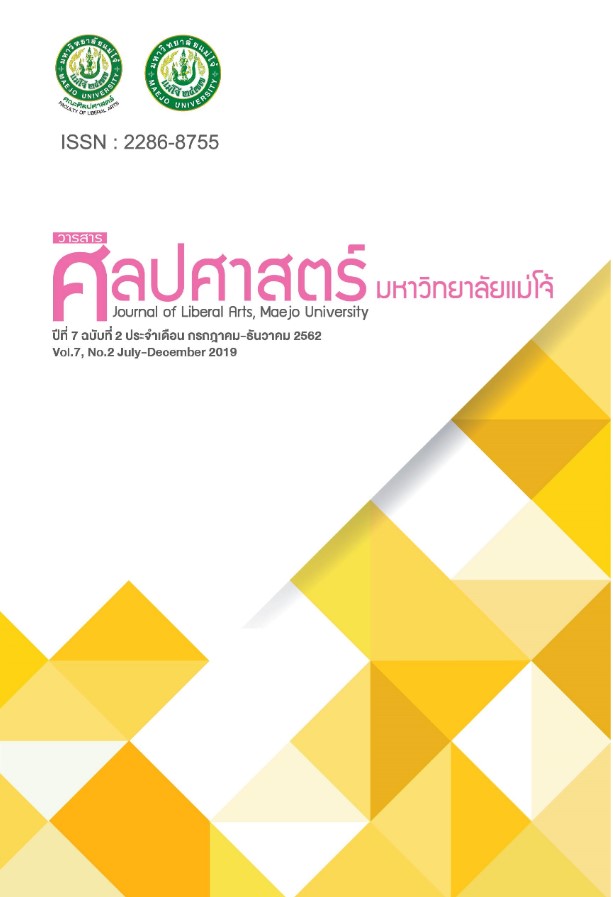The Construction of Otherness in the Identity of Conjoined Twins in Darin Strauss’s Chang and Eng
Main Article Content
Abstract
This research article is aimed at studying the construction of otherness in the identity of conjoined twins in the novel Chang and Eng by Darin Strauss through Disability Paradigms. By analyzing thoughts, actions, and the relationship between a disabled protagonist and other able-bodied characters, the study reveals that
Strauss’s novel presents the otherness in the identity of conjoined twins as the result of defining the conjoined twins’ bodies through the symbolic and medical paradigms of disability, which presents the identity of conjoined twin as the representation of a symbol of evil and a disorder that needs to be treated. This research article presents an analysis of the thoughts of the protagonist Eng Bunker, conjoined twins, and his interactions with other characters who have normative bodies, which reveal the effects of viewing disabled bodies through those paradigms toward the identity of conjoined twins. This research article argues that Strauss’s novel criticizes the viewings of the conjoined twins’ bodies through those paradigms which stigmatize and marginalize those who do not possess standardized bodies as well as render the negative attitude toward their own bodies that leads to the attempt to “cure” and normalize them.
Article Details
References
ถนอมนวล หิรัญเทพ. (2560). วาทกรรมกับความพิการ. วรรณคดีทัศนา 1 วรรณกรรมกับสังคม,คณาจารย์ภาควิชาวรรณคดีเปรียบเทียบ, กรุงเทพฯ: โครงการเผยแพร่ผลงานวิชาการ คณะอักษรศาสตร์จุฬาลงกรณ์มหาวิทยาลัย.
ธีระ นุชเปี่ยม. (2555). การเมืองใหม่ในเวียดนาม?. วารสารดำรงราชานุภาพ, 12(44), 60-77.
นิพัทธ์ ทองเล็ก. (2561). อิน-จัน แฝดสยาม. กรุงเทพฯ: มติชน.
สุทธิพร จิตต์มิตรภาพ. (1990). แฝดสยาม. จุฬาลงกรณ์เวชสาร, 34(12), 965-973. สืบค้น 22 พฤศจิกายน 2562, จาก http://clmjournal.org/_fileupload/journal/126-4-10.pdf
Alan, W.B. (2002). Conjoined Twins in the 16th Century. Twin Research, 5(6), 521-528. Retrieved April 20, 2019, from http://doi:10.1375/twin.5.6.521
Angier, N. (1997). Joined for Life, and Living Life to the Full. New York Times. Retrieved April 20, 2019, from www.nytimes.com/1997/12/23/science/joined-for-lifeand-living-life-to-the-full.html
Barrie, J.M. (2008). Peter Pan. Urbana, Illinois: Project Gutenberg. Retrieved October 7, 2018, from http://www.gutenberg.org/files/16/16-h/16-h.htm
Davis, L.J. (1995). Constructing Normalcy. Enforcing Normalcy: Disability, Deafness,
and the Body. London: Verso.
DeRuiter, C. (2011). Conjoined Twins. Embryo Project Encyclopedia. Retrieved April 18,
2019, from http://embryo.asu.edu/handle/10776/2287.
Dickens, C. (2004). A Christmas Carol. Urbana, Illinois: Project Gutenberg. Retrieved October 7, 2018, from http://www.gutenberg.org/files/46/46-h/46-h.htm From ‘Monsters’ to Modern Medical Miracles: Selected Moments in the History of Conjoined Twins from Medieval to Modern Times. (2013). U.S. National Library
of Medicine. Retrieved April 20, 2019, from http://www.nlm.nih.gov/hmd/ conjoined/age.html
Galton, D. J. (1998). Greek Theories on Eugenics. Journal of Medical Ethnics. (24), 263-267 Retrieved October 7, 2018, from https://jme.bmj.com/content/medethics/x24/4/263.full.pdf
Johnson, D. (2001). An Introduction to Disability Studies. 2nd ed. London: David Fulton.
Kennedy, G.E. (2011). The 3,000-Year History of Conjoined Twins. West J Med. 175(3),176-177. Retrieved April 11, 2019, from http://www.ncbi.nlm.nih.gov/pmc/aticles/PMC1071535/
Munyi, W. C. (2012). Past and Present Perceptions Towards Disability: A Historical Perspective. Disability Studies Quarterly, 32(2), Retrieved October 7, 2018, from http://dsq-sds.org/article/view/3197/3068
Shakespeare, T. (2010). The Social Model of Disability. The Disability Studies Reader, 3rd ed. New York: Routledge.
Strauss, D. (2001). Chang and Eng. New York: Plume. The Case of Conjoined Twins in 10th Century Byzantium. (2014). Medievalist. net. Retrieved April 20, 2019, from http://www. medievalists.net/2014/01/the-case-of-conjoined-twins-in-10th-century-byzantium/
Wallace, A. & Wallace, I. (1978). The Two: A Biography of the Original Siamese Twins. New York: Simon and Schuster.
Wu, C. (2012). Chang and Eng Reconnected: The Original Siamese Twins in American Culture. Philadelphia: Temple University Press.

